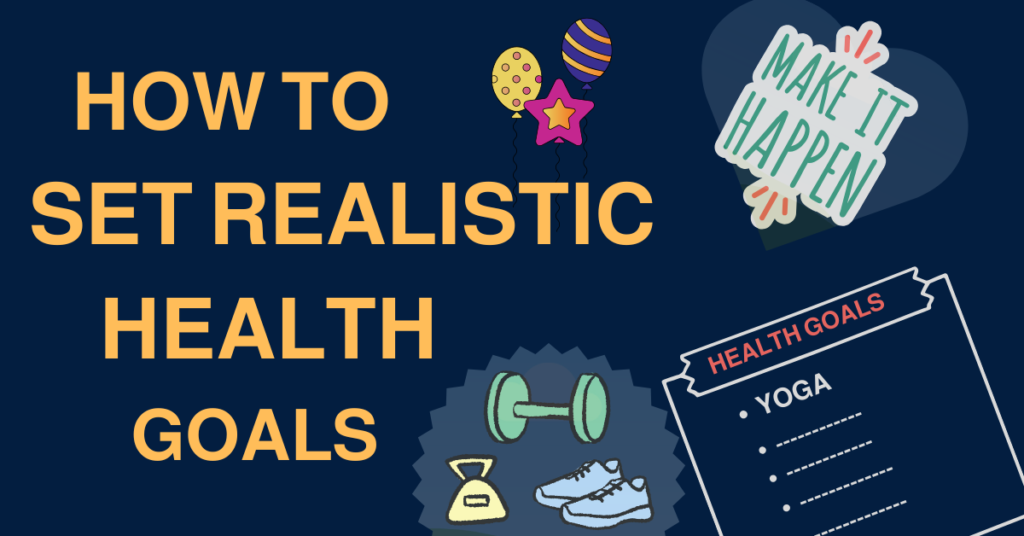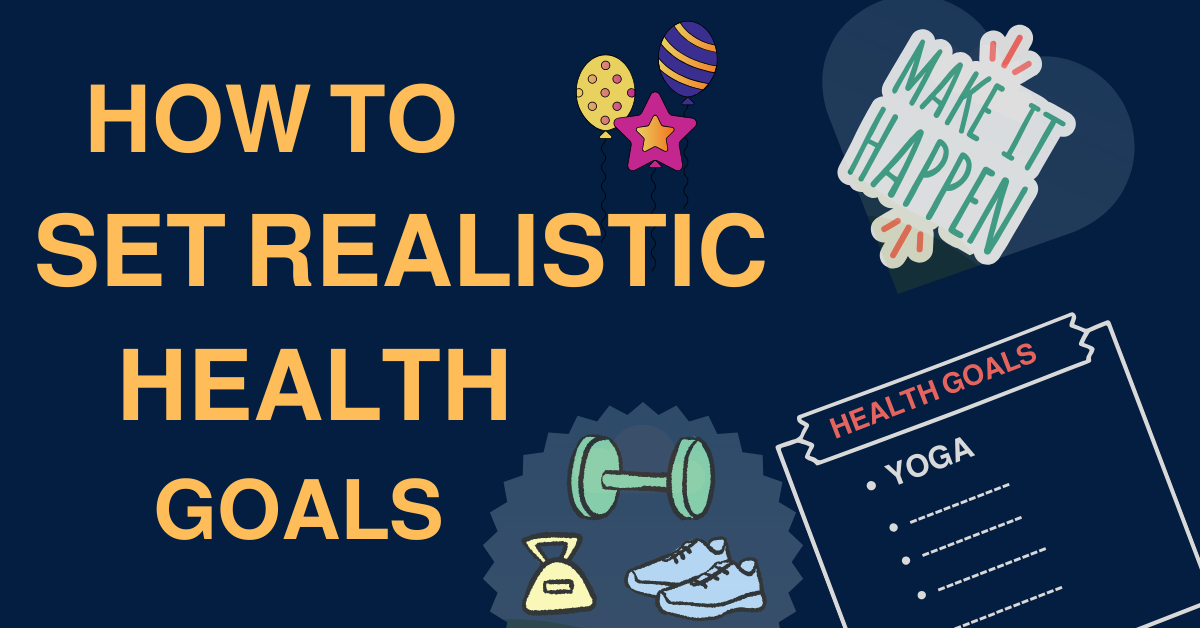The start of a new year is like a blank canvas, full of potential and promise. It’s a time when many of us dream of improving our health, vowing to eat better, move more, and take better care of ourselves. But often, these dreams fail due to obstacles in life. The reason? Many resolutions are simply too high, too unclear, or too disconnected from our everyday realities.
The good news is that you don’t need to set impossible goals to see meaningful change. By planning realistic and personal health goals, you can build a healthier lifestyle step by step.

Table of Contents
10 ways to set realistic health goals
For those dealing with chronic conditions like PCOD, thyroid issues, or chronic inflammation, setting health goals can feel even more challenging. However, adopting simple, healthy habits can make a world of difference. Small changes like staying hydrated, eating nutrient-dense foods, managing stress, and incorporating regular movement can not only help you lose weight but also improve overall well-being. By crafting realistic and personal health goals, you can navigate these challenges and build a healthier lifestyle step by step.
Let’s dive into the ways you can set yourself up for success in the year ahead.
1. Start with Self-Compassion
Before you begin setting goals, take a moment to think where you are right now. Maybe you’ve fallen out of your exercise routine or developed habits you’re not proud of. That’s okay. This is not about criticizing yourself—it’s about meeting yourself with kindness and understanding.
Ask yourself:
- How do I feel physically, emotionally, and mentally?
- What habits have been holding me back?
- What changes can I make to get a positive effect on my well-being?
Starting from a place of self-compassion allows you to focus on growth rather than guilt. It reminds you that change is possible, and you’re worth the effort.
2. Choose Goals That Truly Matter to You
Your goals should be the desire of your heart, not just your head. Think about what really motivates you. Maybe it’s having the energy to keep up with your kids, feeling more confident in your skin, or reducing stress to enjoy life more fully. These personal motivations will anchor you when the journey feels challenging.
For example, instead of saying, “I want to lose 10 kgs body weight,” you could say, “I want to spend more time with my kids while at the same time lose weight so I can play football with my children.” When your health goals are combined with your values, they become a source of inspiration rather than a burden.
3. Make Your Goals SMART
To turn your dreams into actionable steps, use the SMART framework:
- Specific: Define your goal clearly. For example, “I will start drinking 2 liters of water everyday” is more effective than “I will drink more water everyday.”
- Measurable: Include ways to track your progress. For example, “I will walk 10,000 steps a day” provides a measurable target.
- Achievable: Be realistic about what you can accomplish. If you’re new to exercise, start with 15 minutes of activity three times a week instead of aiming for daily workouts.
- Relevant: Make sure your health goals aligns with your priorities and values.
- Time-bound: Set a timeline to keep yourself focused, such as achieving your health goal by the end of three months.
4. Break Goals into Manageable Steps
Big goals can feel overwhelming, but breaking them into smaller steps makes them approachable. For example:
- Big Goal: Build a consistent fitness routine.
- Small Steps:
- Start with less time like 10 minutes of walking three times a week.
- Then increase to 20 minutes after two weeks.
- Add light strength training once a week after a month.
Each small step you take builds momentum and confidence, making the larger goal feel more achievable.
5. Focus on Progress, Not Perfection
Nobody is perfect and you will get disappointed if you long for perfection.What matters most is your overall effort. If you skip a workout or had a heavy meal, don’t let it derail you. Instead, assume that your efforts will not go in vain because of one mistake.
Celebrate the small wins, like choosing a healthy snack or walking an extra block. These little moments of progress are the building blocks of huge wins. Your every step forward will take you closer to your upcoming targets.
6. Make It Enjoyable
Health goals should enhance your life, not feel like a punishment. Don’t force yourself to do things when you hate it. If you hate running, you don’t need to do it. Explore activities that bring you joy, whether it’s dancing, swimming, hiking, or yoga. The same goes for nutrition—find healthy foods you genuinely enjoy rather than sticking to bland “diet” meals.
When you enjoy the process, you will surely do it regularly. Remember, health isn’t about following trends; it’s about finding what works for you and what you enjoy.
7. Surround Yourself with Support
Surrounding with the people who support you to reach your health goals will make a huge difference. Share your goals with someone you trust, whether it’s a friend, family member, or online community. Accountability partners can celebrate your wins, encourage you during setbacks, and help you stay on track.
You can also:
- Track Your Progress: Use a journal, app, or habit tracker to monitor your achievements.
- Join Groups: Participate in fitness classes, cooking workshops, or mindfulness sessions.
- Seek Professional Help: A personal trainer, dietitian, or therapist can provide expert guidance tailored to your needs.
8. Prioritize Holistic Health
True health is not only just about physical fitness but also about your mental health and well-being. Consider goals that address all aspects of your well-being:
- Mental Health: Practice breathing exercises or meditation for at least 10 minutes daily.
- Emotional Health: Write in a gratitude journal each evening.
- Social Health: Spend quality time with loved ones or join a supportive community.
Prioritizing your holistic health helps you create a balanced lifestyle.
9. Reflect and Adjust Regularly
Life is unpredictable, and your goals or health goals may need to evolve along the way. Every month you should try to reflect on your progress and ask yourself these questions:
- What’s working well?
- What challenges am I facing?
- How can I adapt my goals to better fit my current situation?
Being flexible allows you to navigate setbacks without losing sight of your ultimate aspirations.
10. Visualize Your Success
Close your eyes and imagine how you’ll feel when you achieve your goals. Picture yourself energized, confident, and thriving. Visualization is a powerful tool that helps you stay focused and motivated, especially during challenging moments.
Examples of Realistic Health Goals
Here are a few examples to inspire you:
- Physical Health: Walk 7,000 steps daily and do 15 minutes of stretching every morning.
- Nutrition: Add a serving of vegetables to every meal.
- Mental Health: Spend five minutes each day practicing deep breathing exercises.
- Sleep: Create a calming bedtime routine to get 7-8 hours of quality rest.
- Hydration: Drink 5-8 glasses of water everyday.
Conclusion: A Journey of Self-Love
Setting realistic health goals isn’t about striving for perfection or meeting external expectations. It’s about honoring yourself and creating a life that feels good from the inside out. It’s about choosing to show up for yourself, one small step at a time, because you deserve to feel your best.
This year, let your health goals journey be an act of self-love. Celebrate your progress, embrace your imperfections, and trust that every effort you make is a step toward a healthier, happier you. Achieving health goals is definitely not a piece of cake, but reaching targets will make you feel worth it.

